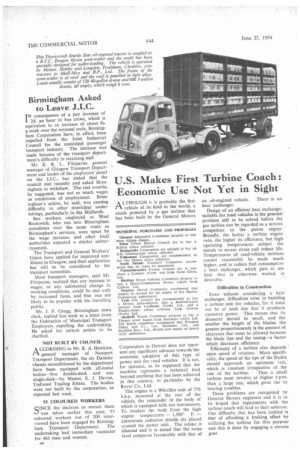U.S. Makes First Turbine Coach: Economic Use Not Yet in
Page 40

If you've noticed an error in this article please click here to report it so we can fix it.
Sight A LTHOUGH it is probably the first vehicle of its kind in the world, a coach powered by a gas turbine that has been built by the General Motors
Corporation in Detroit does not represent any significant advance towards the economic adoption of this type of power unit for road vehicles. It is not, for instance, to be supposed that the machine represents a technical lead beyond anything that has been achieved in this country, in particular by the Rover Co., Ltd.
The engine is a Whirlfire unit of 370 b.h.p. mounted at the rear of the vehicle, the remainder of the body of which is equipped with test instruments. To insulate the body from the high engine temperature — 1,500° F. — aluminium radiation shields ate placed around the power unit. The intake is silenced and it is stated that the noise level compares favourably with that of
an oil-engined vehicle. There •is no
heat exchanger.
Design of an efficient heat exchanger suitable for road vehicles is the greatest problem still to be solved before the gas turbine can be regarded as a serious competitor to the piston engine. Broadly, the hotter a turbine engine runs, the higher its efficiency, but high operating temperatures subject the metals to severe stress, and reduce life. Temperatures of road-vehicle turbines cannot reasonably be made much higher, and to reduce fuel consumption a heat exchanger, which puts to use heat that is otherwise wasted, is desirable.
Difficulties in Construction Even without considering a heat exchanger, difficulties arise in building a turbine unit for vehicles, for it must not be of such size that it produces excessive power. This means that its diameter should be small, and the smaller the length of the blacks, the greater proportionately is the amount of clearance that must be allowed between the blade tips and the casing—a factor which decreases efficiency.
Efficiency of a turbine also depends upon speed of rotation. More specifically, the speed of the tips of the blades should approach an optimum rate, which is constant irrespective of the size of the turbine. Thus a small turbine must revolve at higher rpm. than a large one, which gives rise to bearing troubles.
These problems are recognized by General Motors engineers and it is to be hoped that experiments with ihe turbine coach will lead to their solution. One difficulty that has been tackled is that of affording a braking effect by utilizing the turbine for this purpose and this is done by engaging a reverse gear.




































































































